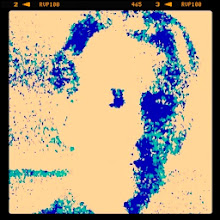By Toby Frost
Reviewed by
Philip Reeve
Most of the books which the
Bee has recommended recently have been aimed at children, so please note that Toby Frost's
Space Captain Smith isn't, containing as it does industrial quantities of smut and innuendo.
Space Captain Smith is set in the 25th Century in a region of space dominated by the 'Great Powers' of Earth, including a revived British Empire keen to export cricket, tea and fair play to the farthest reaches of the galaxy. This suggests that the book will be wedged firmly in the 'Steampunk' cul-de-sac, an impression which is strengthened by Angelo Rinaldi's splendid cover artwork, itself a spoof of the current UK covers for George MacDonald Fraser's
Flashman series .
In fact I was surprised by how
un-Steampunk
Space Captain Smith is: it's true that Smith wears a red tunic, carries a service revolver and prides himself on his well-waxed moustache, but the cultural references are mostly contemporary (his ship's android pilot rather worryingly consults a Haynes manual before take-off) and Smith's muddleheaded but basically decent form of Englishness seems more 1950s than Nineteenth Century. The technology is purest sci-fi, with no actual steam involved, although Smith's ship suffers from a bent cam-shaft at one point. The story is also dotted with parodies of movies like
Blade Runner, The Matrix and
A Clockwork Orange, further diluting the Steampunk aesthetic. (This is a Good Thing: I like my Steampunk diluted to almost homeopathic levels these days.)
The plot is brisk and workmanlike: Isambard Smith (who isn't a Flashman-style cad at all, but a rather dim, well-meaning, upper class twit) is sent to fetch a woman named Rhianna Mitchell from the hippy-ish space habitat of New Francisco, which is under threat from the fascist ant-men of the Ghast Empire. His ramshackle spacecraft the
John Pym is piloted by runaway android Polly Carveth, and also along for the ride is Smith's old friend Suruk the Slayer, a Predator-like alien warrior obsessed with collecting skulls and much given to saying things like, "Moons have passed since last we met, battles fought and enemies fallen. At the bridge of Anrag I took fifteen heads..." How he became Smith's friend is never explained, but it's lucky for us that he did, since his cheerful psychopathy makes him the book's most memorable character, and the source of many of its best jokes.
The three central characters are all likeable and well-drawn, so it doesn't matter that everyone else is basically a charicature. The planets which our heroes visit all seem to have been terraformed according to national stereotype; there's a gloomy post-Russian world full of rotting concrete tower blocks, and a Dixieland bayou planet ruled by 'The Republic of Eden', which basically represents all the things Brits hate about the U.S - religious fundamentalism, gung-ho military types and fat people in pastel leisure suits. (There is a rival 'United Free States of America' which remains off-stage in this book - presumably they stand for Rock'n'Roll,
Seinfeld and HBO dramas.) New Francisco is full of health food shops and meditation groups, while British-ruled planets tend to have names like Didcot and New Dorchester. There's also a planet of cyberpunks who dress like characters from
The Matrix (one lady is described as 'wearing tight shiny things, as if hit by bin-liners in a wind-tunnel') and a rainy world modelled on
Blade Runner ("Go to a
Different Off-World Colony!" suggests the advertising blimp drifting over the mean streets).
These brief movie parodies are all jolly enough in a
Mad Magazine way, but I found them a bit obvious; Toby Frost's own world was more interesting, and I wanted to get back to it. I far preferred the subtler references ("Aliens could look like anything," says a character who has obviously watched
Star Trek, "They might look just like us except for some extra bits on their heads...")
I was also a bit put off by the almost ceaseless innuendo. I know that the
double entendre is part of a long tradition in British comedy, from Max Miller and saucy seaside postcards through the
Carry On films and TV shows like '
Allo 'Allo, but, let's be honest, all those things were
rubbish. Sexual innuendo was only ever funny because it had a shock value in a society where sex itself could not be mentioned. We no longer live in such a society, so lines about 'being taken up the bayou' etc. etc. are just a lazy substitute for humour; the empty husks of gags our grandparents might have sniggered at. There are times when
Space Captain Smith swerves dangerously close to becoming a sort of
Carry On Stainless Steel Rat.
Humour is always a hit-and-miss affair, however, and Toby Frost's jokes work far more often than they fail. He's often very funny, and, more importantly, he can
write. His book is at its best when it stops frantically referencing other things and is just itself: the action scenes in particular are surprisingly gripping and well handled, and the universe he has created, for all its deliberate silliness, has a certain hand-made logic of its own.
 Space Captain Smith
Space Captain Smith probably won't change your life, but it's not meant to. It delivers some good gags wrapped up in a story that will keep you turning the pages, and it might brighten up a wet weekend, or while away a train journey: I'm always pleased to find a book that does that. There are already two sequels,
God Emperor of Didcot and
Wrath of the Lemming Men, and I shall be ordering both of them as soon as I've posted this. Three cheers for the British Space Empire!
 Toby Frost's Space Captain Smith website, including some downloadable short stories, is here.
Toby Frost's Space Captain Smith website, including some downloadable short stories, is here.
































